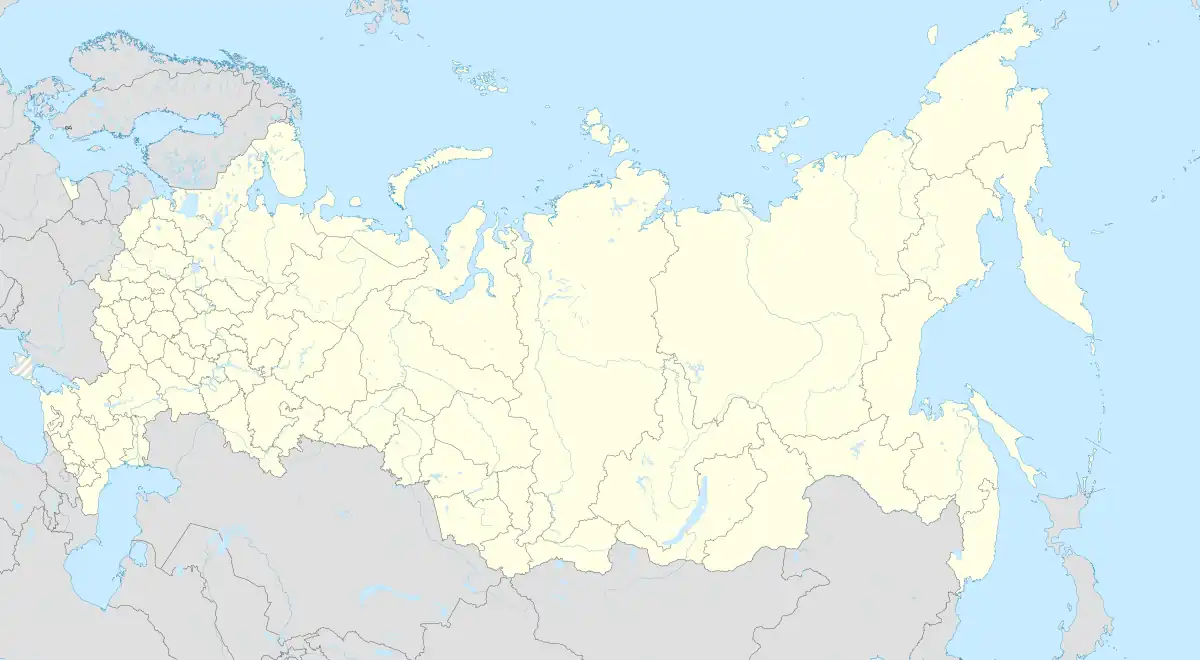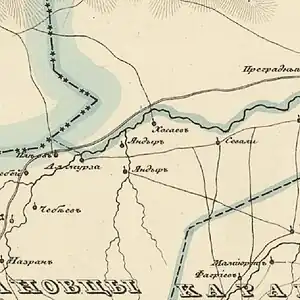Yandare
Яндаре | |
|---|---|
| Other transcription(s) | |
| • Ingush | Яндаре[lower-alpha 1] |
 | |
Location of Yandare | |
 Yandare Location of Yandare  Yandare Yandare (Republic of Ingushetia) | |
| Coordinates: 43°16′09″N 44°54′31″E / 43.26917°N 44.90861°E | |
| Country | Russia |
| Federal subject | Ingushetia |
| Founded | 1772 |
| Population | |
| • Total | 7,980 |
| • Estimate (2021)[8] | 9,999 |
| • Subordinated to | Nazranovsky District |
| Time zone | UTC+3 (MSK |
| Postal code(s)[10] | 386243 |
| OKTMO ID | 26605450101 |
Yandare (Ingush: Яндаре, romanized: Yandare[lower-alpha 1]) is a rural locality (a selo) in Nazranovsky District of the Republic of Ingushetia, Russia. It forms the municipality of the rural settlement of Yandare as the only settlement in its composition.[11][12]
Geography
The village is located on both banks of the Yandyrka River, just above its confluence with Sunzha, 7.5 km northeast of the regional center — the city of Nazran and 15 km northeast of the city of Magas.
The nearest settlements: in the north — the city of Karabulak, in the northeast — the stanitsa of Troitskaya, in the southeast - the stanitsa of Nesterovskaya, in the south - the village of Surkhakhi, in the southwest - the village of Ekazhevo and in the west - the villages of Gazi-Yurt and Plievo.[13]
History

The territory of Yandare, together with the villages of Gazi-Yurt, Surkhakhi, Ekazhevo, Ali-Yurt and the modern city of Magas, forms one of the largest archaeological complexes of the ancient settlements of the Alanian period, where, according to Ingush researchers, the historical city of Magas, the capital of the medieval state of Alania,[14] was located, which included the territory of modern Ingushetia.[15]
In 1833, an uprising broke out in Yandare, led by Dzhankhot Azamatov. In July of the same year, it was suppressed by troops. The houses of Dzhankhot Azamatov and his relatives were burned down. The destruction of the entire village was stopped due to the intercession of the Nazranian Ingush.[16]
In the period from 1944 to 1958, after the deportation of Chechens and Ingush and the abolition of the Chechen-Ingush ASSR, the village was called Raydzast.[17][18] After the rehabilitation and return of the Ingush people to Ingushetia, the village was returned to its historical name — Yandare.
Infrastructure
The village has one central and 4 jamaat mosques, 3 secondary schools, madrasa, a House of Culture, as well as a village library and an outpatient clinic. Not far from the mosque there is a stele dedicated to the participants of the Great Patriotic War of 1941-1945.
Notes
References
- ↑ Uzhakhov 1927, p. 85.
- ↑ Волкова 1974, p. 167.
- ↑ Оzdoyev 1980, p. 831.
- ↑ Барахоева, Кодзоев & Хайров 2016, p. 31.
- ↑ Кодзоев 2021, p. 648.
- ↑ Мальсагов 1963, p. 146.
- ↑ Russian Federal State Statistics Service (2011). Всероссийская перепись населения 2010 года. Том 1 [2010 All-Russian Population Census, vol. 1]. Всероссийская перепись населения 2010 года [2010 All-Russia Population Census] (in Russian). Federal State Statistics Service.
- ↑ "Таблица 5. Численность населения России, федеральных округов, субъектов Российской Федерации, городских округов, муниципальных районов, муниципальных округов, городских и сельских поселений, городских населенных пунктов, сельских населенных пунктов с населением 3000 человек и более". Всероссийской переписи населения 2020 года
- ↑ "Об исчислении времени". Официальный интернет-портал правовой информации (in Russian). 3 June 2011. Retrieved 19 January 2019.
- ↑ Почта России. Информационно-вычислительный центр ОАСУ РПО. (Russian Post). Поиск объектов почтовой связи (Postal Objects Search) (in Russian)
- ↑ "Закон Республики Ингушетия от 23 февраля 2009 года № 5-рз «Об установлении границ муниципальных образований Республики Ингушетия и наделении их статусом сельского поселения, муниципального района и городского округа»".
- ↑ "Поиск кодов ОКАТО. Сельское поселение Яндаре, Назрановский район". Archived from the original on 2015-11-18.
- ↑ "Map of Chechnya and Ingushetia".(rar) (not earlier than 1995). Volume 8 MB
- ↑ Долгиева et al. 2013, pp. 117–120.
- ↑ Шнирельман 2006, p. 180.
- ↑ Акты, собранные Кавказской археографической комиссией: Том VIII (in Russian). Тифлис: Тип. Главного Управления Наместника Кавказского. 1881. p. 696.
- ↑ Ведомости Верховного Совета РСФСР № 5 1958
- ↑ Указ Президиума Верховного Совета РСФСР от 23 февраля 1945 г. «О переименовании некоторых сельских советов и населённых пунктов Грозненской области»
Bibliography
- Uzhakhov, M. G. (1927). Ингушско-русский словарик [Ingush-Russian Dictionary] (in Ingush and Russian). Vladikavkaz: Kraynatsizdat. pp. 1–185.
- Волкова, Н. Г. (1974). Этнический состав населения Северного Кавказа в XVIII — начале XX века [Ethnic composition of the population of the North Caucasus in the 18th - early 20th centuries] (in Russian). Москва: Наука. pp. 1–276.
- Оzdoyev, I. A. (1980). Оzdoyevа, F. G.; Kurkiyev, А. S. (eds.). Русско-ингушский словарь: 40 000 слов [Russian-Ingush Dictionary: 40,000 words] (in Ingush and Russian). Мoscow: Russian language. pp. 1–832.
- Барахоева, Н. М.; Кодзоев, Н. Д.; Хайров, Б. А. (2016). Ингушско-русский словарь терминов [Ingush-Russian dictionary of terms] (in Ingush and Russian) (2 ed.). Нальчик: ООО «Тетраграф». pp. 1–288.
- Кодзоев, Н. Д. (2021). Хайрова, Р. Р. (ed.). Русско-ингушский словарь [Russian-Ingush dictionary] (in Ingush and Russian). Ростов-на-Дону: Типография «Лаки Пак». pp. 1–656. ISBN 978-5-906785-55-8.
- Мальсагов, З. К. (1963). Оздоева, Ф. (ed.). Грамматика ингушского языка [Grammar of the Ingush language] (in Ingush and Russian). Vol. 5 (2nd ed.). Грозный: Чечено-Ингушское Книжное Издательство. pp. 1–164.
- Долгиева, М. Б.; Картоев, М. М.; Кодзоев, Н. Д.; Мамиев, Т. Х. (2013). История Ингушетии (in Russian) (4 ed.). Ростов-на-Дону: Южный издательский дом. pp. 1–600. ISBN 978-5-98864-056-1.
- Шнирельман, В. А. (2006). Калинин, И. (ed.). Быть Аланами: Интеллектуалы и политика на Северном Кавказе в XX веке [To be Alans: Intellectuals and Politics in the North Caucasus in the 20th Century] (in Russian). Москва: Новое Литературное Обозрение. pp. 1–348. ISBN 5-86793-406-3. ISSN 1813-6583.